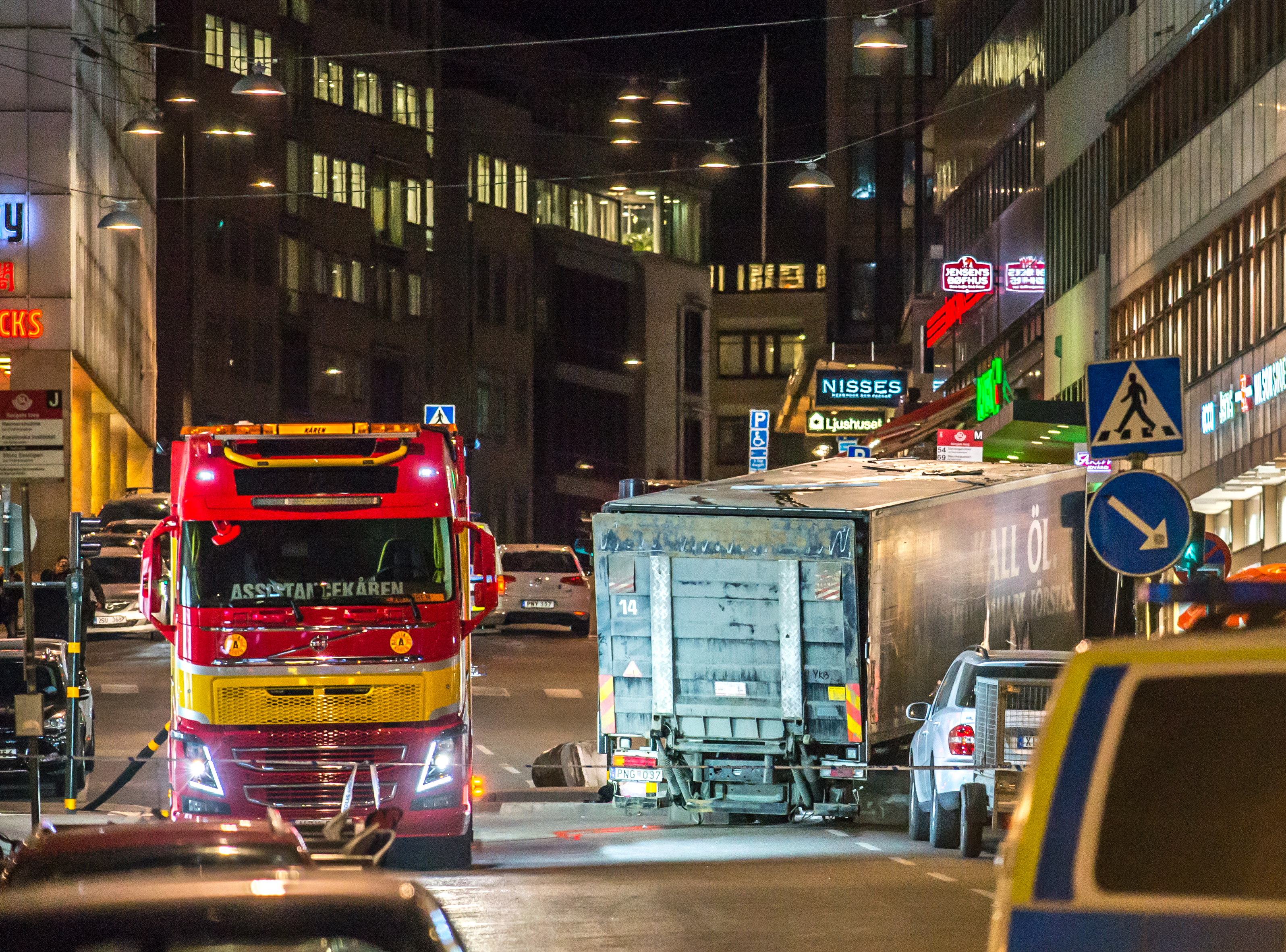
The last few decades have seen the mainstreaming of a very particular kind of crime — vehicle ramming.
According to the US Department of Homeland Security, this is when a perpetrator deliberately aims a motor vehicle at a target with the intent to inflict fatal injuries or cause significant property damage by striking with concussive force. And it’s a problem for cities, law enforcement, and carmakers.
This week, it was front and center in many people’s minds when a man driving a speeding car crashed into a Christmas parade in Milwaukee, killing five people and injuring 48 others.
There’s nothing to suggest that this week’s attack was a deliberate act of domestic terrorism. However, it raises the issue of what happens when a vehicle hits a group of people on impact — deliberate or otherwise.
It could be the man who has a heart attack at the wheel and rams into a crowd of people (happened opposite my local supermarket). Or what I classify as general fuckwit driving. Or someone following their sat-nav voice commands a little too closely.
But the issue remains — whatever the motive and the cause, vehicles are crashing into pedestrians at high speed, and it’s not only a problem in terms of criminality, but also safety.
The long criminality of vehicle ramming
Whether it’s a car or a truck driving through a parade, a protest, or a shopping precinct, vehicle ramming is a low-tech attack designed to cause havoc, fear, and serious injury.

Vehicle ramming has been used by extremist groups such as ISIS and Al Qaeda in cities like London, Antwerp, Nice, Ohio, Barcelona, and Berlin, where cars and trucks were used as weapons, charging at pedestrians in crowded civilian areas. It’s also been an act of the mentally ill in Melbourne.
It would be easy to suggest that vehicle ramming has become popular because terrorists can’t easily hack a plane anymore, but it’s more complicated than that.
While vehicle ramming has a pretty long history, it’s accelerated (excuse the pun) over the last decade. In particular, vehicle ramming has been deployed in the US against protestors over the last few years.
This includes attacks aimed at Black Lives Matter protests. For example, from the day of George Floyd’s death on May 25, 2020, to September 30, 2021, vehicles drove into separate protest events at least 139 times, according to a Boston Globe analysis.
Is vehicle ramming a crime?
In the US, five states — Arkansas, Florida, Iowa, Oklahoma, and Tennessee — have either shielded drivers who kill pedestrians from legal action or have fully decriminalized hitting a pedestrian with a vehicle if they were in the street or on a highway.
The laws grant drivers criminal and civil immunity if they “unintentionally” hit or kill a protester while “fleeing from a riot,” so long as they say it was necessary to protect themselves.
An easy way to cause havoc
If you’re looking for a way to cause havoc without even needing a gun, vehicle ramming is for you. Heck, you don’t even need much planning, you just need to hire a car or truck or fill your own vehicle with gas. You don’t even need to be a good driver.
The problem of truck ramming
Research by the Mineta Transportation Institute found that the British government has issued guidance to trucking companies and truckers to increase the security of their vehicles against theft.
This includes pre-employment checks, improving security in truck yards, CCTV, controlling access by contractors and visitors, actions by drivers to prevent vehicle theft. Other tactics incl keeping route and scheduling information confidential, reporting suspicious behavior, and promptly reporting thefts.
Even better, thanks to IoT, many commercial trucking fleets have remote tracking devices that enable the monitoring of route deviations.
Could we take this one step further? Could trucks that deviate from their route autonomously contact emergency services and instigate remote shutdown capabilities?
Can automakers stop these attacks?
Part of the problem is that a moving car or truck can suddenly veer into pedestrians in a matter of seconds—a vehicle traveling 50 km miles an hour can travel 180 meters, a standard street length in many cities, in 15 seconds.

In the 2016 Berlin attack, terrorists drove a truck through a local Christmas market. There was one thing that stopped it from being far worse. The assailant’s truck stopped early during the attack, potentially saving many lives. The truck was fitted with an automatic emergency braking system, which are now mandatory for heavier trucks in the EU.
EU Regulation No. 347/2012 specifies the technical requirements and test procedures for advanced emergency braking systems (AEB). These detect the possibility of a collision, warning the driver by a combination of optical, acoustic or haptic signals. If the driver takes no action, AEB automatically applies the vehicle’s brakes.
Automatic Emergency braking works automatically, without the driver actually touching the brake pedal.
All AEB systems detect vehicles, and many can sense pedestrians and cyclists. It aims to initiate breaking.
Forward Collision Warning
The other factor in the equation is forward collision warning (FCW) in cars and trucks. FCW operates just before AEB. It lets off a sound, signal, or vibration to let the driver know a collision is imminent. This gives them a chance to react and press the brakes.
Ideally, if they fail to act, then AEB intervenes.
Is the tech good enough to stop vehicle ramming?
I would say not yet when it comes to high-speed deliberate acts. It’s simply not designed for people driving intentionally at high speed.
Forward collision warning systems that come with pedestrian detection systems are fairly new. In 2019, it was announced that manufacturers were progressing to equip every new passenger vehicle with crash avoidance technology by September 1, 2022.
The tech is still a work in progress, with 2019 research by the American Automobile Association showing automatic emergency braking systems commonly fail to detect pedestrians and seldom work at night.
Further, a false positive may lead a driver to slam on the brakes, rear-ending them. Or it may fail to be operated. It’s also possible in some cars to override these functionalities.
Earlier this month, Tesla recalled nearly 12,000 US vehicles sold since 2017 because a communication error may cause a false forward-collision warning or unexpected activation of the automatic emergency braking system.
A federal commitment to crash avoidance technology
The recent $1.2 trillion infrastructure bill includes a commitment to crash avoidance technology with a requirement to establish minimum performance standards for crash avoidance detection and to require that vehicles manufactured in the US come equipped with a forward collision warning and automatic emergency braking system.
So, will we see deliberate car-ramming attacks from autonomous vehicles?
There’s a lot about how autonomous vehicles could be the terrorist weapon of choice. Where are all these autonomous attacks?
The incidents we’ve seen so far are dumb attacks technology-wise. You could equally cause carnage in a smart city — without even leaving your home. You could hack traffic lights, disable train signals, turn off street lights at night, or raise bridges.
Or you could fly a drone with an explosive into a crowd. Hire an Uber. Or unleash a hacked delivery bot.
Ultimately, vehicle ramming is a complex topic. It requires collaboration between cities, law enforcement, and automakers.
Technology can’t will away the intent to do evil, unfortunately. Nor will the behavior be deterred if its not prosecuted as a criminal offence.
Get the TNW newsletter
Get the most important tech news in your inbox each week.




